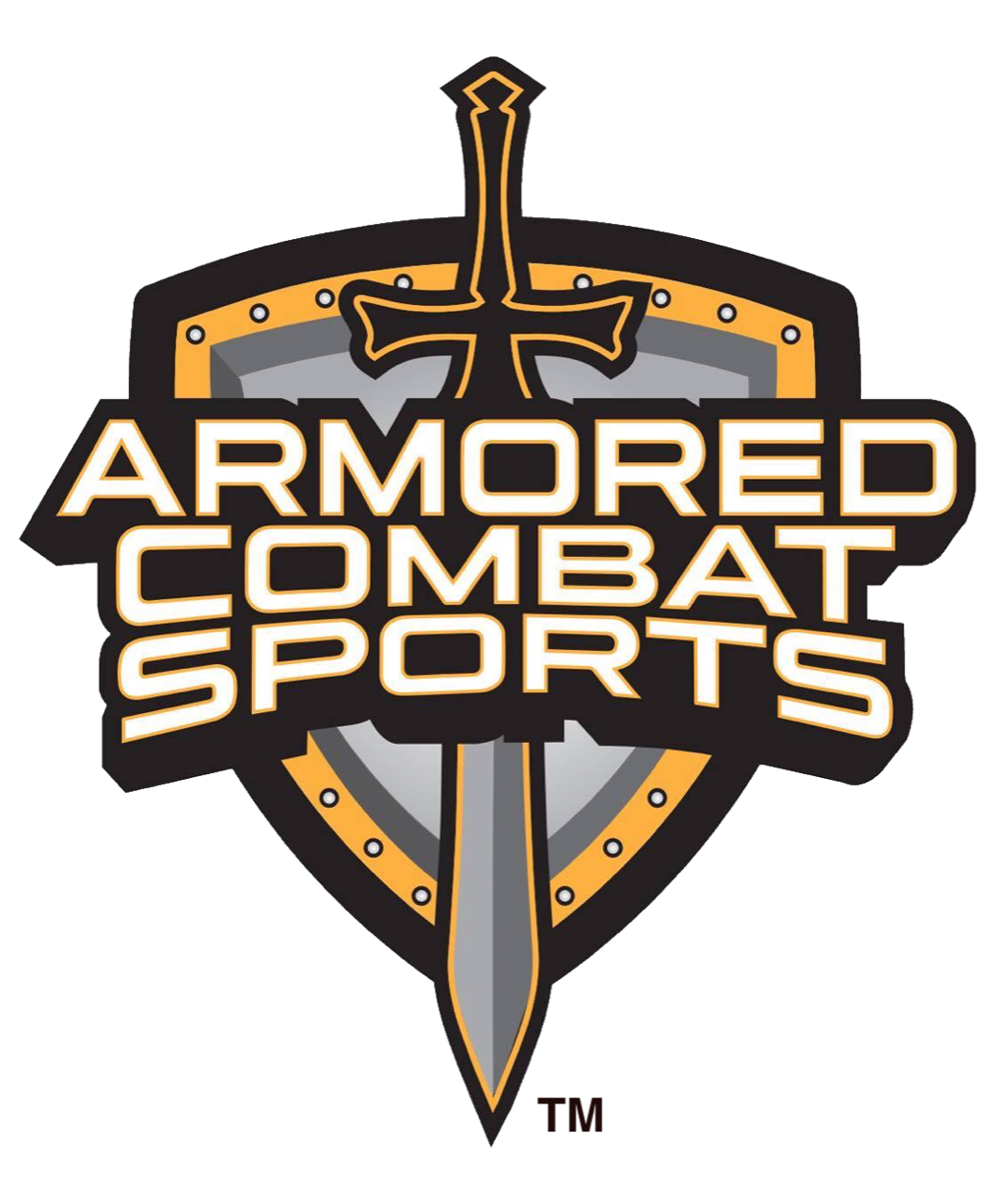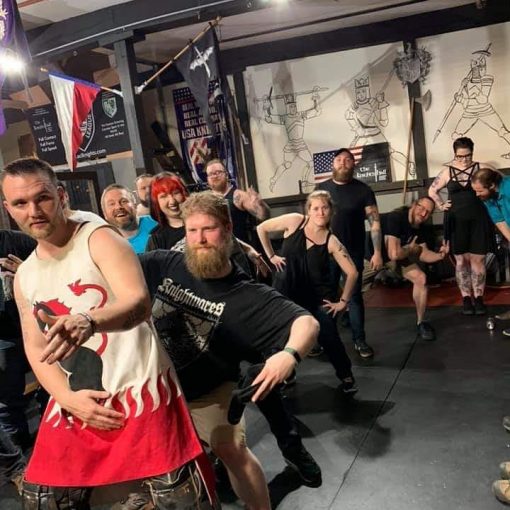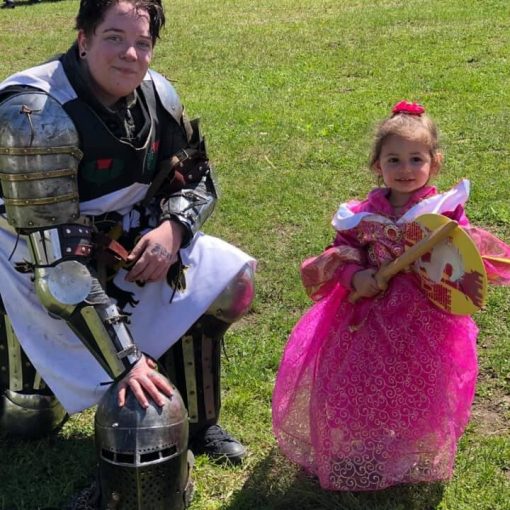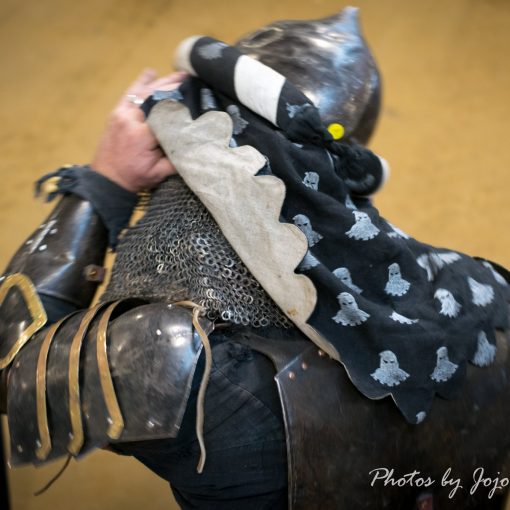(Meet The Support Team) Part 1
By Jana Brooks
Fighters have a lot to think about. Diet, training, armor, armor upkeep, comportment on and off the field, getting to practice, juggling work/ life/ balance, worry of letting teammates down, making it to an event on time and the list goes on. Sometimes it can be overwhelming to let this largely life-encompassing sport squeeze into an already fully packed life. But one of the beautiful things about our fighting community is that the individual is not alone. Enter the Support Team…
Currently comprised of volunteers (oh for the day when it might become a paid professional gig!), the Support Team becomes a collaborative art. Multiple people, fulfilling essential roles that dance, swirl (and sometimes collide) with each other to create a seamless production for our guests, the audience. “SHOWTIME” is not just about the fighter, it’s about the team, “support and fighters” working in unison.
This is the first in a series of articles for those who want to help but aren’t sure what to do. They see the role of the fighter but aren’t necessarily aware of the many other important people who drive the success of a show. It’s also for our community so that as a fighter, a referee or just someone who wants to understand how things work can see what it takes to put on a Fighting Combat show. Most importantly, I hope that this series will serve as a subtle reminder of the many ways that someone can become involved in a production, even if they never plan to fight. Armored Combat Sports values its membership and we invite each member to consider taking a more active role in future productions.
The Quartermaster
Wikipedia describes The Quartermaster as a military term – “a quartermaster is generally a relatively senior soldier who supervises stores or barracks and distributes supplies and provisions.” Merriam Webster says it’s ” an army officer who provides clothing and supplies for soldiers.” “GoARMY.com” it says it’s an “Officer’s job is to ensure the functionality of all Army equipment and systems, and to provide supply support for Soldiers.”
Derived from the Old French quartier and the Latin quartarius, the term literally means “master of quarters”.
In Armored Combat Sports, the Quartermaster means supply and support. It’s a crucial role that eliminates some of the worry for the fighter, keeping him focused on the fight ahead while creating a functional atmosphere so that the show may go on. Having a Quartermaster on your support staff, (or even better, one Quartermaster dedicated to each team), will rise the production level of your next show to a higher standard.
Lets take a look at the surcoat.
We all know that one fighter. He may be a superstar in the field. But when left to his own devises, the armor comes off, his surcoat tangled with it in a big knotted mess. Later, when he has time, his concerns will be on taking care of his armor so he pulls off the surcoat which then gets tossed in a heap at the bottom of his armor bin. The poor thing will be abandoned there, never see the light of day until it’s showtime once again. At this point, the unfortunate surcoat is stiff with old sweat, possibly blotted with blood or worse, and smelly black dots of mildew have crept around it’s edges. No amount of smoothing the stiffened rumples with his hands will restore it to it’s former glory, so with a shrug, our fighter pulls it over his head, belts it in place (because the ties were sliced off by a sword in the last battle), and into the ring he goes, hoping the audience doesn’t notice and are too faraway to smell him!
Now let’s imagine this same scenario with a Quartermaster at the helm. The fighter arrives at the event where a rack of uniforms have mysteriously appeared. They are all cleaned and pressed, mended of holes, ties replaced, lovingly hung on a rack and ready for action. The fighter doesn’t have to worry one minute about how he will look on the field. He only has to make sure he has his armor and his weapons and he’s ready to rock.
At the end of the event in a perfect world, the fighter removes his uniform and hangs it back on the rack before removing his armor. (The fighter doing this is mostly “wishful thinking” on the Quartermaster’s part.) But one by one the uniforms do reappear back on the rack, whether by a conscientious “Squire” (another important job position in the Support Team structure) or the Quartermaster him/herself. At this point the fighter is only vaguely aware that the surcoat along with all the other uniforms, such as belts, squire’s aprons, referee jerseys, possibly garb if at a Renaissance Fare, etc., are accounted for and whisked away to be washed, pressed, mended and arranged for the next event.
Its almost like magic! And you have the power to be a magician too!
Here is a list of items a Quartermaster may be responsible for providing at any given event:
- Surcoats
- First aide kit
- Water
- Spare belts
- Squire aprons
- Squire’s repair kit
- Trash bags
- Paper towels
- Tables/chairs
- sharpies
- Easily accessible stationary location where everyone knows where to get their things.
Other support team members that the Quartermaster works with;
well, that would be just about everyone!
If the Quartermaster doesn’t know the first thing about sewing then the surcoats will need to be washed and returned to the team tailor. The Quartermaster may set up the first-aide station, but that doesn’t mean he/she knows the first thing about patching up injuries. The Quartermaster may be on location to hand out uniforms, but its the Squire’s job to make sure they aren’t put on backwards and that the ties are tied and hidden.
*Tables, chairs and trash cans aren’t always procured by the Quartermaster. Sometimes the event site will take care of this. A good “Site Organizer” (another position on the Support Team) will make sure such things are readily available. It is the Quartermaster’s job to make sure that trash cans, tables and chairs are where they need to be and that they are placed in convenient locations. We can’t have fighters tripping over trash cans, throwing their gauntlets on the first-aide table or leaving empty water bottles and other refuse on the ground because the garbage bags were overflowing. The Quartermaster makes sure the behind the scene areas are organised, clear, clean and tidy.
The following photos demonstrate the Quartermaster kit when traveling to an event.


*Note that the rack is on top and therefore packed last. That’s because its the first thing to set up.
*Tip – Fold and pack all the uniforms still on their hangers. It cuts your time in half when doing set up.






Even though it may be in open view and very near every other fighter it’s important to stake out a territory for each person fighting.
Five tips for Fighter’s staging area:
1) Keep it free of clutter
2) Make it “easy access” to their kit.
3) Give them “room to change” into their armor.
4) Keep it separate enough from their neighbor’s kit so they don’t mix up the pieces.
5) before event remind fighters to put their names on each piece of their equipment!
It’s not always easy to set up the fighter’s staging area at events, but keep these five tips in mind whenever possible and there will be a lot less chaos in the armory tent!
*Note – The armor boxes are great because they automatically make that, “dressing room” space for their staging area.
They also keep all the bits and personal stuff contained during the fighting.
**Side bonus – they are sturdy enough for makeshift chairs.

Fighter’s wear anywhere from fifty to eighty pounds of gear before they put on their helmet. While some fighters are agile enough to sit on the ground, it won’t be comfortable for long and they will need a chair. It’s important to provide them with places to rest between bouts.
Chairs or benches need to be sturdy.
Any chair or bench with cloth or foam seats/back rests are just asking to get torn if allowing an armored person to sit on them.
Tips for providing rest for fighters:
1) Keep the sitting area free of clutter.
2) Keep area easy to access and in the shade if possible.
3) Keep sitting areas away from the “Staging areas” where fighters are changing (unless they are the fighter’s personal seat).
4) Be prepared to “nicely” chase away non fighters.
(Often people are oblivious when they are sitting in a spot where a tired fighter needs to rest.)
***Note – Resting areas make excellent locations to hand out water.
Thank you for reading about the duties of a Quartermaster. If you would like to help with your local team, but aren’t sure what to do, consider being a Quartermaster. It’s a unique job that will make your team efficient, organised and more professional.




